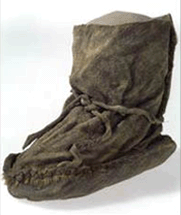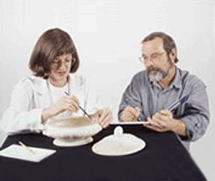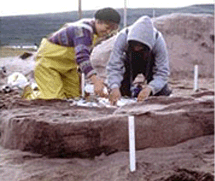Conservation and scientific services for archaeology
The Canadian Conservation Institute's (CCI) archaeological conservators and scientists can offer advice, guidance, and services based on a state-of-the-art research program combined with field experience on wet, dry, and frozen land sites.
Advisory and on-site services
CCI offers field conservation services and visits to your museum or storage facility, including:
- pre-excavation planning advice incorporating information on materials and supplies needed for different types of sites;
- field conservation services comprising recovery of fragile artifacts in the field, "first aid" for artifacts, packing, and field storage;
- advice and assistance on collections storage, including facilities surveys and storage of archaeological archives; and
- advice on preventive conservation.
Treatments
CCI can carry out complete treatments in their laboratory facilities, provide advice and monitor treatments carried out at your institution, or do portions of treatments that require specialized equipment. Staff members are experienced in the treatment of a variety of materials from wet, frozen, and dry sites, including:
- organic materials, e.g. wood, textile, skin, leather, basketry, bone, antler, ivory, and baleen
- metals, e.g. iron, copper, silver, tin, lead, and their alloys
- ceramics and glass
- composite artifacts, e.g. metal/organic components
CCI also offers specialized parylene coating for consolidation of extremely fragile objects, vacuum freeze-drying of organic materials, and preparation of specialized display and storage mounts.
Analysis and testing
CCI uses a number of scientific techniques to characterize archaeological objects and can address a wide range of questions, including:
- materials identification, e.g. wood, fibre, pigment, and metal identification
- characterization of deterioration
- artifact documentation by scientific and technical photography and radiography

Sealskin kamik excavated from Banks Island, NT (from the collection of the Prince of Wales Northern Heritage Centre).

Assessing and cleaning a ceramic artifact.

Blocklifting fragile objects intact from archaeological excavations allows them to be studied in a laboratory.
Training
Training can be developed to meet the specific requirements of your institution or program, and can include:
- field schools;
- lectures or sessions as part of an academic program;
- seminars on the conservation of wet organic materials, inorganic materials, ceramics, and glass;
- conference workshops on field techniques or preventive conservation for archaeological collections; and
- internships at CCI.
Research
The services CCI offers to the archaeological community are supported by many years of experience in treating objects, and extensive research into deterioration, conservation processes, and materials. Projects have included numerous studies on the following;
- conservation of waterlogged wood;
- conservation of composite artifacts;
- characterization and conservation of skin and leather;
- consolidation of fragile objects with parylene;
- treatment and storage of archaeological iron; and
- recording and replication of fragile artifacts using laser scanning and 3D printing.